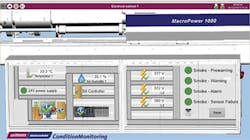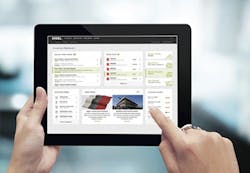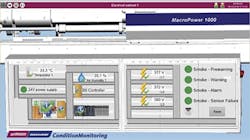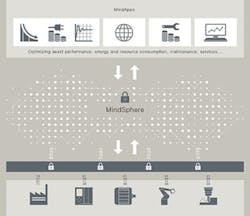Special Report: Predictive maintenance keeps processors ahead of problems
Plastics processors are looking for ways to reduce unplanned downtime, and equipment manufacturers are helping them meet those goals by embracing the concept of predictive maintenance.
Instead of waiting for a part to break and shut down production, or relying on a suggested maintenance schedule that could result in unnecessary maintenance, manufacturers increasingly are maximizing machine uptime by analyzing data collected by sensors. The data is sent over the Internet to software that attempts to identify maintenance needs before a failure occurs.
The software can alert the processor to perform maintenance, and in some cases, it can even order the necessary replacement parts.
Here are some of the latest developments from equipment and component suppliers.
Engel
Engel debuted its e-connect.monitor at the K show; it allows a service technician to check the status of critical injection molding machine components during operation, analyze the data online, and make a reliable prognosis about the remaining service life of certain components.
"The biggest advantage is you can move the downtime from unplanned to planned," said Wolfgang Degwerth, VP of sales and customer service for Engel North America. "You don't want to have downtime in a critical situation where you would need to deliver parts to a customer."
The e-connect.monitor collects data from a variety of sensors, including ultrasonic transducers. Ultrasonic transducers measure actual wear to the plasticizing screw, therefore eliminating extended downtime for barrel and screw disassembly and inspection.
Until now, to assess the condition of a screw on a large injection molding machine, the operator had to schedule two to three workdays of downtime to remove, clean and measure the screw. However, the new technology allows an Engel service technician to temporarily mount an ultrasonic transducer on the outside of the screw barrel. The device captures ultrasonic signals of the barrel. The data is then uploaded to Engel's algorithmic software. Customers can access the results and any maintenance suggestions via Engel's e-connect customer portal.
An assessment of the screw is now available within minutes instead of days.
"With these measurements, we save a lot of time and downtime," Degwerth said. "This is a really, really huge improvement of that process."
While Engel at first is supplying its service technicians with the ultrasonic sensors, it hopes eventually to integrate the equipment into its injection molding machines so the monitoring can be done continuously.
In addition to monitoring the condition of plasticizing screws, Engel's e-connect.monitor can also monitor the wear of the spindles that actuate the axial movements in electric injection molding machines. Since there are multiple spindles operating in each machine — and the failure of any one of them will bring the entire production cell to a standstill — the condition of the ball screw drives is monitored continuously.
Engel already can integrate sensors into injection molding machines to monitor ball screw drives continuously and online. Engel makes use of a variety of sensors, including acceleration sensors and temperature sensors, for data collection.
In real time, this data gets uploaded to Engel's servers, where the algorithms automatically analyze the data and diagnose the condition of the spindles. The results are communicated to the customer online along with maintenance recommendations.
The operator then could call up the current condition of individual spindles at any time and would be notified immediately if a spindle's condition becomes critical. In the future, the system also could automatically order spare parts and schedule an appointment with a service technician.
While the Engel system currently monitors only screws and spindles, the company is working on new ways to monitor other process-critical parts, including components of hydraulic machines.
Engel's new injection molding machines come with the e-connect.monitor, but it will be possible to use the ultrasonic screw measurement technology with older machines. Degwerth said the company will offer retrofit solutions.
Wittmann Battenfeld
Wittmann Battenfeld is encouraging predictive and condition-based maintenance for injection molding machines by introducing CMS, the company's condition monitoring system.
Unlike many tools that rely almost entirely on software to predict when maintenance should be performed, Wittmann Battenfeld says it combines technology with human diagnostic competence.
Sensors measure criteria including vibrations, torque, temperatures, air humidity, oil quality, flow quantities, screw function and all data from the control cabinet. Special process control software analyzes the data. Specialists, either at the customer's plant or at the Wittmann Battenfeld service center, evaluate the data and condition analysis before deciding what type of maintenance might be needed.
The resulting maintenance schedule reduces overall costs and results in an increase in machine availability.
"Downtime effects losses for each manufacturing plant," the company said. "CMS supports the goals of condition-oriented maintenance significantly by planned service operations and inspections."
With condition-based maintenance, service can be performed before faults emerge, according to the company. With traditional methods, corrective maintenance is done after breakdowns occur or inspections fail. Remote monitoring is possible, with remote logins available to both molders and Wittmann Battenfeld technicians.With predictive maintenance, software can enhance performance and predict errors by analyzing trends and patterns.
"CMS is a combination of condition-based and predictive maintenance," the company said.
Adopting a condition-based maintenance schedule can reduce, but not eliminate, preventive maintenance. By catching a potential breakdown before it occurs, condition-based monitoring can also reduce costs associated with consequential damage.
Currently, four CMS installations are in test operation with customers in Europe. Official sales are planned for the third quarter of 2017.
Novatec/Prophecy Sensorlytics
In January, Prophecy Sensorlytics and its sister company, Novatec, began shipping pumps equipped with failure-predicting sensors and Prophecy's Crystalball monitoring software. The sensors now are standard equipment on Novatec pumps, with three months of free monitoring included.
Prophecy also recently began supplying its PumpSense technology to pump manufacturers other than Novatec.
It is marketing its technology to pump manufacturers serving the agricultural, electronics, environmental, food and beverage, medical, mining, paper, printing, pharmaceutical and textile industries.
In addition, Prophecy is finalizing its plans to sell a retrofit version of the PumpSense predictive maintenance and analytics system to users of older Novatec pumps as well as competitors' pumps in the plastics industry.
"The next step in this parade is releasing a PumpSense retrofit for the rest of the population of people who have existing pumps, whether they be Novatec or competitors' pumps," said Conrad Bessemer, executive chairman of Prophecy and president of Novatec. "That is what we're going to focus on. We have been testing those as a retrofit for quite some time."
Prophecy plans to begin shipping the retrofit version of its PumpSense system within weeks.
"We're working on our stocking plan right now, and we expect to be fully ready to start shipping the first week of June," said James Zinski, the company's president and COO.
Pumps in processing plants are vital to manufacturing as they convey resin pellets, flakes and powders to the machines.
"A pump is usually hidden away, sort of like the water heater in your basement or the heat pump outside your house, and most people don't look at these things until they fail," Bessemer said. "As a result, when they do fail, those people are not able to convey plastics to the machines, which means they aren't making parts. At that point, when you're not making parts, you aren't making money."
PumpSense helps processors avoid that situation by identifying equipment problems before they result in breakdowns.
Sensors can measure vacuum pressure, vibration, temperature, sound and magnetic field. The information then is transmitted wirelessly to Prophecy's cloud-based servers, which can diagnose components operating outside of normal parameters.
"Because of vibration differences, we actually can figure out whether the filter is dirty, whether the oil level is low or high, or whether the viscosity of the oil is correct," Bessemer said.
The system also can detect bearing condition, valve condition, belt tension level, gearbox condition and rotor/starter health.
The ability to diagnose equipment health through vibration sensors has been around for 30 to 40 years, but cost of the sensors was prohibitive. Bessemer said decreasing technology costs in recent years have made the PumpSense system economical. And the company's software, which can translate the measurements and changes in measurements into actionable maintenance advice, makes it easy for operators to use. In the past, a company would need someone with significant training to interpret the data.
Currently, about 95 percent of the plastics industry does not use vibration sensors, but they should, Bessemer said.
"The equipment really does have a voice; it just can't be heard," he said. "The machines are starting to scream, but no one is listening to the fact they are screaming until it finally gives up the ghost and dies, and then you're out of luck."
Prophecy can transmit the results to a user's smartphone, laptop, desktop computer or tablet.
"You log into your account and you can see the result for any one machine or a zone of machines," Bessemer said. "You can also get text alerts to learn things are going out of spec."
In addition to PumpSense, Prophecy also is releasing MachineSense, which uses the same type of vibration, temperature, pressure, sound and magnetic field monitors to analyze and predict the health of moving machine components and subassemblies in various industrial applications. In the plastics industry, applications for primary equipment would include extruders and injection molding machines.
Right now, Prophecy is providing MachineSense technology to multiple OEMs in pilot programs, including some in the plastics industry. It also plans eventually to release a retrofit version of MachineSense that could be installed on existing equipment.
ABB Robotics
Last year, ABB Robotics introduced Connected Services, a suite of services that increases robot uptime, optimizes performance, suggests predictive maintenance, and extends a robot's lifetime, according to the company. Connected Services was created to help robot operators identify and solve issues with all vital components within a robot system, said Helen Ke Feng, the company's global plastics and rubber industry segment manager.
All ABB robots are ready to be connected wirelessly or hardwired to the Connected Services software suite. Certain services, including condition monitoring and diagnostics, are provided free during the initial warranty period. Users can continue the services after the warranty ends for an annual fee.
The condition monitoring and diagnostics service uses built-in sensors and software analytics to monitor a robot's performance and identify trends that could indicate trouble. The system can identify the most frequent causes of robot failure and immediately alert operators if any problems are detected.
Among the conditions monitored are:
• trends and alarms,• fan speed and temperature,• power supply and energy consumption,• software resources and system status,• speed and torque.
The MyRobot web interface can receive alarms and monitor robots via smartphone, tablet or personal computer. Alarms can also be sent by email and text message.
In addition to condition monitoring and diagnostics, there are four more services available in the Connected Services portfolio. Each service costs an additional annual fee:
• Backup management helps customers restore robot programming from backups.• Remote access provides secure remote connectivity and expert assistance.• Fleet assessment allows users to compare a robot with robots in ABB's entire fleet of connected robots to better prioritize service needs.• Asset optimization, includes deep analysis of a robot or robot fleet, generating reports with improvement suggestions for maximum performance.
Milacron
Milacron doesn't typically use the term "predictive maintenance" for its offering; the company's software and hardware offers "predictive indicators," said Mike Prachar, VP of marketing for global machinery. Milacron's offering can identify when an injection molding machine is operating outside of normal parameters and send alerts, which allow users to isolate problems by analyzing the machine's data. The system does not, however, identify which exact component is failing and when that will happen.
"It is predictive in a holistic sense, but it is not predictive in being timeline- or timeframe-specific, being that you need to change pump No. 3 in two months," Prachar said. "However, if deployed properly, Milacron's Advanced Analytics is capable of providing users predictive capability through alerts, frequency and experience. It is identifying there is a problem within your process, but as we have seen in injection molding machines, one component that is slightly off could affect two others. An injection molding machine is a complex system; it is not just a motor, pump or clamp. That is why we're looking at overall performance of the machine and its processes vs. an individual component."
The company offers a remote monitoring system as part of its Milacron 4.0 suite. Milacron injection molding machines can send operational data from sensors over the internet to Milacron servers, allowing the information to be analyzed to determine if any problems are developing.
While remote monitoring isn't new to Milacron, the company is continuing to refine and enhance its offerings.
"Over the last 12 months, Milacron has been focused on enhancing our Milacron 4.0 toolset, specifically our Advanced Analytics," Prachar said. "This toolset allows the user to evaluate, track, analyze and graph over 300 variables related to machine performance, such as cushion, transfer point, injection pressures, energy, temperature, leveling, etc. Within the Advanced Analytics interface, the user is able to set up numerous alarms, based on defined thresholds, providing real-time feedback on the system performance."
Together with historical data and key metrics, information can be converted into valuable predictive indicators that, together with tracking and notifications, assist the user in identifying areas that are out of statistical control and determine potential causes, such as screw wear, oil contamination or overheating.
"We would refer to this as experience-based predictive maintenance fueled by data and analytics," Prachar said.
Siemens
Siemens is working with plastics machinery OEMs to develop preventive maintenance solutions for processors.
"Siemens provides the framework — the cloud service, programming tools and electrical hardware — and our customers are then either designing their own apps or using our preconfigured apps," said Mathias Radziwill, Siemens business development manager for plastics.
The OEMs can develop apps that take information, such as vibration or energy usage data, and offer maintenance suggestions. The data analyzed and the type of maintenance recommendations vary by OEM.
"The real advantage is that our customers can use the cloud-based service with off-the-shelf hardware. The collected data is encrypted and transported to the cloud, and the OEM can design their own apps or use our preconfigured apps for energy analytics or smart condition monitoring," Radziwill said.
Siemens is marketing its cloud-based services for industry under the name MindSphere.
"It is really up to our customers to design their own apps," he said. "We've discovered this has become an additional revenue stream for our customers. They can offer this to their customers to prevent machine shutdowns and to monitor specific areas of their machines such as vibration data."
The latest upgrade to Siemens' technology is adoption of the OPC-UA communication protocol. The protocol simplifies communications between PLCs from different suppliers. For example, it makes it easier for a Siemens-supplied PLC on one piece of equipment to communicate via the cloud with any other PLC that supports OPC-UA.
Bruce Geiselman, senior staff reporter
For more information
ABB Robotics Inc.,Auburn Hills, Mich., 248-391-9000, www.abb.com/robotics
Engel Machinery Inc.,York, Pa., 717-764-6818, www.engelglobal.com
Milacron LLC,Cincinnati, 513-536-2000, www.milacron.com
Novatec Inc.,Baltimore, 410-789-4811, www.novatec.com
Prophecy Sensorlytics LLC,Baltimore, 443-457-1165, www.prophecysensorlytics.com
Siemens Industry Inc.,Norcross, Ga., 800-743-6367, www.usa.siemens.com
Wittmann Battenfeld Inc.,Torrington, Conn., 860-496-9603, www.wittmann-group.com
About the Author
Bruce Geiselman
Senior Staff Reporter Bruce Geiselman covers extrusion, blow molding, additive manufacturing, automation and end markets including automotive and packaging. He also writes features, including In Other Words and Problem Solved, for Plastics Machinery & Manufacturing, Plastics Recycling and The Journal of Blow Molding. He has extensive experience in daily and magazine journalism.






